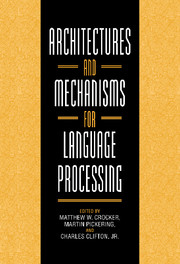Book contents
- Frontmatter
- Contents
- Contributors
- Preface
- 1 Architectures and Mechanisms in Sentence Comprehension
- Part I Frameworks
- Part II Syntactic and Lexical Mechanisms
- Part III Syntax and Semantics
- Part IV Interpretation
- 13 On Interpretation: Minimal ‘Lowering’
- 14 Focus Effects Associated with Negative Quantifiers
- 15 Constraints and Mechanisms in Theories of Anaphor Processing
- Author Index
- Subject Index
15 - Constraints and Mechanisms in Theories of Anaphor Processing
Published online by Cambridge University Press: 03 October 2009
- Frontmatter
- Contents
- Contributors
- Preface
- 1 Architectures and Mechanisms in Sentence Comprehension
- Part I Frameworks
- Part II Syntactic and Lexical Mechanisms
- Part III Syntax and Semantics
- Part IV Interpretation
- 13 On Interpretation: Minimal ‘Lowering’
- 14 Focus Effects Associated with Negative Quantifiers
- 15 Constraints and Mechanisms in Theories of Anaphor Processing
- Author Index
- Subject Index
Summary
Background
One of the most intriguing questions about the use of reference in language has to do with the multiplicity of possible forms that can be used to successfully identify a referent in a given situation. For example, a certain dog can be referred to by the definite descriptions the dog or the animal, by the proper name Fido, or by the pronoun he. Clearly, referential forms are not used randomly, and furthermore, their distribution exhibits some consistent patterns within and also across languages (Ariel, 1990; Givón, 1976). The question is then, what constraints underlie the distribution of referential forms and more specifically, what psychological mechanisms are involved in the production and resolution of referential expressions? The study of this question spans several disciplines which emphasize different aspects of the relevant issues.
Research in cognitive psychology on conceptual representation and categorization focuses on the question of what makes a certain expression more likely to be used for naming a certain object or event in the world (e.g., Rips, 1989; Rosch, 1978; Rosch & Mervis, 1975). The emphasis in this research is on how people's mental representation of world knowledge underlies naming and categorization. In contrast, much research in linguistics and psycholinguistics focuses on the study of anaphoric expressions that are linked to referents by being coreferential with another linguistic expression, the antecedent. As in the case of referring expressions in general, there is more than one anaphoric form that can be used to successfully identify the antecedent.
- Type
- Chapter
- Information
- Architectures and Mechanisms for Language Processing , pp. 341 - 354Publisher: Cambridge University PressPrint publication year: 1999
- 1
- Cited by



